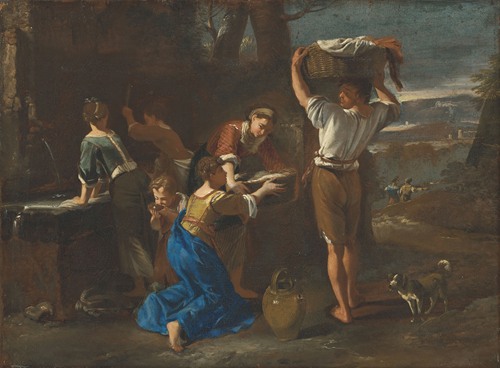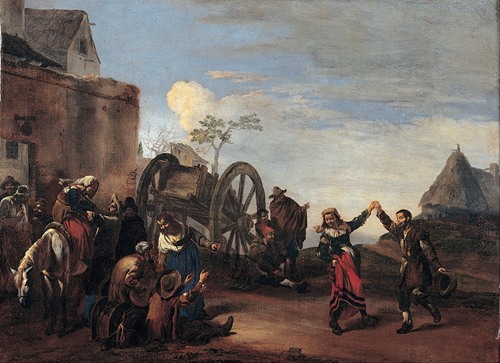
Michelangelo Cerquozzi, known as Michelangelo delle Battaglie was an Italian Baroque painter known for his genre scenes, battle pictures, small religious and mythological works and still lifes. His genre scenes were influenced by the work of the Flemish and Dutch genre artists referred to as the Bamboccianti active in Rome who created small cabinet paintings and prints of the everyday life of the lower classes in Rome and its countryside. One of the leading battle painters active in Italy in the first half of the 17th century, Michelangelo Cerquozzi earned the nickname 'Michelangelo delle Battaglie' ('Michelangelo of the Battles').
Michelangelo Cerquozzi was born in Rome as the son of Marcello Cerquozzi and Lucia Vassalli, both Roman citizens. His father was a successful leather merchant and the family was well-off. Michelangelo Cerquozzi started his artistic training at the age of 12 in the studio of Giuseppe Cesari, a history painter in whose studio the young Caravaggio trained upon his arrival in Rome.
Various biographers and scholars describe Cerquozzi as an artist in close contact with the circle of Flemish and Dutch artists active in Rome. They place him in the period 1620-1621 as living or working in Rome alongside Jacob de Hase (also known as Giacomo Fiammingo), an Antwerp painter of battles who came to Rome in 1601. He may have studied with Jacob de Hase before this date. In 1624 he lived with the Dutch painters Paulus Bor originally from Amersfoort and Jan Harmansz originally from Reims, and during 1625-1630 with the Fleming Willem Michiels. By 1631, he had a studio with his pupil Matteo Bonicelli and Michiels.
The work from his early period is not well-known. He painted some battle paintings and also produced still life paintings which imitated the work of Pietro Paolo Bonzi, a still life specialist.
Cerquozzi joined the Accademia di San Luca in 1634 and attended their meetings until 1652. However, he never followed their strict decorum.
Cerquozzi gradually gained recognition starting from 1630 and his works sold very well to all classes of patrons. The early sponsorship of purchasers such as the merchant Dominico Viola played an important role in launching his career. He was also able to secure commissions from prominent patrons including professionals such as the lawyer Raffaelo Marchesi and the doctor Vincenzo Neri and aristocratic clients from the circle of the Barberini family, the Colonna family, Cardinal Rapaccioli, Modenese Count Camillo Carandini, count Carpegna and Monsignor Raggi. Many of his patrons were from circles that supported the Spanish cause in Italy. Cerquozzi would also collaborate on designs of Famiano Strada's De Bello Belgico celebrating Alessandro Farnese's campaigns to recapture the Spanish Netherlands for the Spanish emperor.
His friends included Pietro da Cortona, Giacinto Brandi, and Cornelis Bloemaert. Among his pupils were Matteo Bonicelli and Giovanni Francesco Gerardi.
Cerquozzi never married and remained childless. When he died on 29 March 1660 in Rome in his house located near the Spanish Steps he had become a very wealthy artist with important financial and property holdings.



